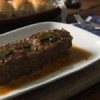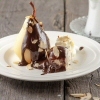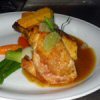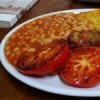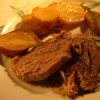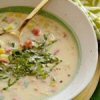USEFUL INFORMATION

So far as possible I have avoided using technical terms on this site. Rather, I have relied upon describing the actions needed. However, if this site is to serve as an introduction to more advanced cookery (as I hope it will) you might find some of the following information useful...
 BAIN-MARIE:
BAIN-MARIE:
A water bath used for gentle cooking (or for keeping food warm). The dish in which the food is to b cooked is placed in a roasting tin containing hot water. This is maintained at just below simmering heat.
BASTE:
To spoon hot melted fat, oil or butter over food (usually meats) to moisten and assist in the cooking.
BEAT:
To use a fork (or sometimes a spoon) in rapid circular movements to mix ingredients or turn them into paste.
BEURRE MANIÉ:
Equal parts of butter and flour, kneaded together to form a paste and used to thicken soups, sauces and casseroles. The casserole must be below boiling point when the beurre manié is added, a little at a time, beating thoroughly after each addition until incorporated. The casserole is then brought to the boil to thicken.
BLANCH:
To boil a vegetable for less than its normal cooking time. Often done prior to freezing; also in some recipes where the vegetable will be further cooked at a later point.
BLIND BAKING:
Blind-baking (sometimes called "pre-baking") is the process of baking a pie crust or other pastry without the filling. Blind baking a pie crust is necessary when it will be filled with an unbaked filling (such as with pudding or cream pies) or when the filling has a shorter bake time than the crust. Blind baking a pie crust also helps prevent the pie crust from becoming soggy from its filling.
Generally, the pie crust is lined with tin foil or parchment paper, then filled with dried peas, lentils, beans or other pulses, or with ceramic or metal "baking beans" (also called pastry weights or pie weights) so that it will keep its shape when baking. Alternatively, the crust is poked repeatedly with the tines of a fork to produce small holes--this helps the steam escape and prevents the crust from bubbling up. After the pie crust is done, the temporary filling is replaced with the proper filling.
Blind-baking also helps to form a nice pastry case for the filling as it has already been partially formed from blind-baking.
BOIL:
To cook ingredients in water (or other liquid) at about 212ºF (100ºC) so that the liquid bubbles rapidly.
BOUQUET GARNI:
A small bunch of mixed herbs tied together with thread. It is used to flavour dishes during cooking and is extracted afterwards. A bouquet garni normally consists of a bay leaf, 2 or 3 sprigs of parsley and a sprig of thyme.
BRAISE:
To cook gently in a greased or buttered pan with the lid on, either in the oven or on the hob.
CHOP:
To cut something into small pieces, usually on a flat wooden, ceramic or plastic chopping board.
COAT:
To cover an item completely with another ingredient. For example, one coats something with flour when one ensures that the surface is complete covered with the flour.
DEGLAZE:
To detach sediment in a pan or roasting dish in which meat has been cooked. The residue that is detached helps to enhance the flavour of sauces or gravy. A little stock or wine is added to the pan while scraping, to incorporate the sediment.
DICE:
Similar to chopping except that one ensures that the ingredient is cut into small, even-sized cubes.
DISSOLVE:
When a solid ingredient (for example a stock cube) is 'melted' in a liquid (e.g. hot water).
FRY:
To cook over heat in a pan with oil, butter, lard beef dripping or other fat.
GLAZE:
To brush an item with either beaten egg or milk so that, when it is cooked, it has a slightly shiny surface.
GREASE:
To rub the inner surface of a pan, dish or roasting tin with a fat to help prevent the cooked food from sticking.
MARINATE:
To soak ingredients (usually meats) in a liquid for a long period of time in order for them to become more tender and absorb some of the flavour of the liquid.
MASH:
To use a food masher, fork or electric food processor to break down solid foods like potatoes) into a smooth paste.
MINCE:
To break down large solid pieces of food (usually meat) into much smaller pieces. This can be achieved wither with a hand mincer that screws to the work surface, or with an electric food processor.
PARBOIL:
To only partly cook ingredients (usually vegetables) by placing them in boiling water for just a few minutes so that they remain quite firm.
QUENELLE:
The Quenelle shape is formed into an smooth oval similar to a football or a three-sided eliptical shape that is used to make a pleasing presentation for the semi-soft foods being served. This shape is achieved with the use of two spoons of the same size that are held in each hand so the bowls of the spoons face and are positioned next to each other. The first spoon scoops out a spoonful of the food being moulded and as it does, this forms the first side of the Quenelle as it is held in the bowl of the spoon. The bowl of the second spoon is then pressed against one side of the scooped contents that are being held in the first spoon in order to start the process of forming the second side, creating a ridge running from the tip of the spoon to the handle. Since the first side was formed as the first spoon scooped out the original scoop of food, it is now time to rotate the first side that was formed as it is being held in the first spoon. This is done so the spoons can remain facing each other, making it easier to form the third side. Therefore, as the second spoon presses down and against the contents held by the first spoon while forming the second side of the Quenelle, slide the spoon down and into the first spoon to remove the contents. The third side is then easily formed using the first spoon. When the desired look has been achieved, the food is ready to be placed on a plate for serving.
The semi-soft to semi-firm textures of the foods make them easy to shape into a smooth oval. Foods often served with a Quenelle shape include ice cream or sorbet desserts, rice, mashed potatoes, soft cheese, mixed vegetables, and ground or minced meats. The size of the Quenelle is dependent on the serving size, so the individual servings of potatoes or desserts may typically be much larger than the individual servings of cheese, unless the serving is to be created for more than one person. Thus, smaller spoons may be used to mould the shape if the serving size is to be smaller in dimension.
REDUCE:
To boil a liquid for long enough to reduce the volume and thus strengthen the flavour.
SAUTE:
To toss an ingredient (such as meat) into hot fat in a pan so that it seals in the meat juices.
SHRED:
To slice vegetables into thin strands.
SIMMER:
To heat a liquid to just below boiling point. The liquid bubbles gently.
STIR-FRY:
Much used in Chinese cooking where oil is heated in a pan until it's very hot. The ingredients are cut thinly then added to the hot oil, sometimes for just a few seconds since they will cook very quickly. As the name suggests, one should keep stirring throughout the cooking process.
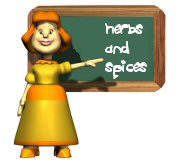 Herbs and spices need not necessarily impart a strong flavour to food. Bouquet Garni is a good example of this where the delicate flavours are so subtle and yet make a great deal of difference to the final dish. Obviously, some spices can be quite strong (curry or chilli to name but two) and these should be added to food with care.
Herbs and spices need not necessarily impart a strong flavour to food. Bouquet Garni is a good example of this where the delicate flavours are so subtle and yet make a great deal of difference to the final dish. Obviously, some spices can be quite strong (curry or chilli to name but two) and these should be added to food with care.
There is now a wide range of herbs and spices readily available and the following are those commonly found in many recipes. Most can be bought in ready-to-use powder form which make them easy to store. Once you have mastered basic cooking techniques, you will almost certainly want to experiment a little with new tastes and ideas.
 BASIL: If used fresh, basil adds a wonderfully exotic taste to fresh Tomato and Mozzarella Salad and can also be used in its dried for in sauces, soups and with fish.
BASIL: If used fresh, basil adds a wonderfully exotic taste to fresh Tomato and Mozzarella Salad and can also be used in its dried for in sauces, soups and with fish.
BAY LEAVES are the dried leaves of the laurel tree and thus not precisely a herb. However, since many recipes call for the addition of a bay leaf (or boquet garni where a bay leaf is included) it is as well to mention it here. A word of caution, though... never use more than one or (maximum) two bay leaves in any recipe since, in excess, they can cause the heart rate to increase.
CHERVIL is much used in French cooking and is part of their 'fines herbes' mixture. Its flavour is a rather delicate aniseed and makes a nice addition to some sauces and soups. Add it to an omelette for a different flavour.
CHIVES is a much grown herb that looks like a tiny onion shoot (with a similar, but milder, taste). It can be used in salads or added to plain-tasting cottage cheeses.
CORIANDER is one of the aromatic herbs that is often added to a curry. It can, in small quantities, be added to a vinegar dressing to give it some 'bite'
CUMIN is often added to savoury sausages to give them more flavour. In addition, there are some delicate cheeses that incorporate whole cumin seeds.
DILL has a strange combination of sweet sour and caramel! It is claimed to be an aid to digestion.
FENNEL: Since fennel is now being used more and more as an ingredient for soup or as a vegetable on its own, some controversy exists as to whether it is a vegetable or a herb. It has a strong aniseed flavour and can be finely chopped in a salad or cooked whole or in slices with a fish dish.
GARLIC: My favourite!! The whole bulb (called a 'head') comprises several smaller bulbs (called 'cloves') which are chopped or crushed for use in many recipes. Take note of Graham's Hot Tips however, if you want to get close to anybody after eating garlic; it can have an unmistakable and very noticeable 'after-effect'!
HORSERADISH: A very strong mustardy-flavoured herb that is popularly used in a sauce with beef.
MINT grows easily and profusely in most climates. A few leaves added to a cooking pan of new potatoes adds a gentle flavour. More commonly, it is chopped with vinegar and a little sugar to make mint sauce, which goes well with lamb.
PARSLEY is a 'must' for any cook who wants to produce quality food. It has a mild yet distinct flavour and can be used both as an ingredient and as a decoration. It is one of the three herbs that make up a bouquet garni.
TARRAGON is another herb that's popular in French cooking. Perfect for enhancing the flavour of some sauces.
THYME: A wild-growing herb that looks a little like heather. Has an unmistakably lemon scent and is excellent to add to many dishes, either on its own or as part of a bouquet garni. Essential in any kitchen.
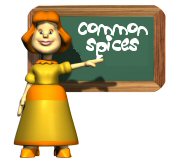 CARDAMOM is available either in the form of seeds or powdered. It is much used in curries since it has a strong aromatic flavour. In The Middle East it is either crunched or added to strong coffee to help remove the odour of garlic (clearly they have not read Graham's Hot Tips!)
CARDAMOM is available either in the form of seeds or powdered. It is much used in curries since it has a strong aromatic flavour. In The Middle East it is either crunched or added to strong coffee to help remove the odour of garlic (clearly they have not read Graham's Hot Tips!)
CATENNE PEPPER is red and got! Use sparingly in curries and chillies.
CINNAMON is bought either in stick form or powdered and is generally used to add a sweet but spicy flavour to fruits and desserts.
CLOVES look like small dark brown floral buttons with several points. They are excellent for adding flavour to apple dishes or to onions whilst cooking. I often push one or two into an onion while I am making a stock. They should not be eaten, however, since they have a strong, piquant flavour.
CORIANDER is an aromatic spice that is available either in granules or in powdered form. Its aroma has a hint of aniseed and it can be added to stews and other meat dishes.
GINGER: I always keep a jar of dried ginger powder in the kitchen. It can also be bought fresh in good food stores. When fresh, it resembles a small, lumpy, pale brown root (which needs peeling before you can use the fibrous interior).
GROUND MACE is, in fact, the shell of the nutmeg. If a recipe asks for mace and you do not have any, you will not notice a deal of difference if you use grated nutmeg instead.
NUTMEG has a very distinct spicy flavour and is used in many recipes. It can be purchased either as small nuts that need to be grated, or already ground into a powder.
PEPPER: I always use freshly ground pepper in my cooking. I find that the mixed peppercorns give the best results.
PIMENTO PEPPERS are very hot and very red! Use only with great care in dishes like chilli con carne.
SAFFRON is a very delicate yellow spice that can be used to add flavour and colour to rice and other plain-tasting dishes. Based on weight and volume, it is very expensive.
STEAK PEPPER is not, in fact, any different from normal black peppercorns except that the peppercorns have already been crushed. I keep a jar handy because some recipes ask for 'crushed' (as opposed to 'ground') peppers and this saves me the trouble of having to do it by hand.
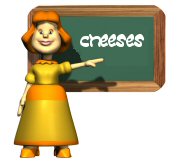 There are so many different cheeses available (the French alone have almost 400 different types) that it can be quite confusing to know which one to use. I have, therefore, included twelve of the most popular ones, and briefly explained their appearance and uses.
There are so many different cheeses available (the French alone have almost 400 different types) that it can be quite confusing to know which one to use. I have, therefore, included twelve of the most popular ones, and briefly explained their appearance and uses.
Connoisseurs would say that you never refrigerate a cheese, but just keep it pleasantly chilled. Most of us can't afford the luxury of a chill room, in which case, all cheeses should be covered and kept in the refrigerator but removed an hour or two before use since the taste is at its best when the cheese is at room temperature.
BRIE is one of France's best known cheese. The 'best of the best' is Brie de Meaux (pronounced "mow"), originating from the town of Meaux, east of Paris. Brie has a furry white outer skin which some people remove but is, in fact, perfectly good to eat. Inside, it is a soft, creamy off-white cheese with a clean, crisp taste. If you want to eat it as the French intended, allow it to stand at room temperature for at least two hours before serving. A Brie is said to be 'ripe' (in excellent condition to eat) when the inside begins to 'melt. A hard, commercial Brie is not worth buying!
CAMEMBERT is a medium strength soft, white cheese from France. despite its mild flavour, it can often develop a 'healthy' smell so should be kept covered at all times. Like Brie, Camembert has a furry white outer skin which some people remove but is, in fact, perfectly good to eat
CHEDDAR is a hard cheese of British origin and is probably the most versatile for cooking. It has a taste that is full but not strong. It's easy to grate or slice and it melts easily and quickly when used in cooking.
DANISH BLUE is a slightly soft, blue-veined cheese with a slightly salty flavour. Quite strong in taste, it is ideal on a dry biscuit at the end of a good meal (unless you are eating the French way, where the cheese course comes before the dessert).
EDAM is one of the 'great Dutch cheeses'. In the cheese market in Den Haag and Gouda, one can see huge 'sledges' of these cheeses being sold. The red outer casing (a type of wax) should be cut off, leaving a good solid yellow interior. Lower in fat content than many other cheeses, Edam can be consumed even by the diet-conscious.
GOATS CHEESES are becoming more popular. Though there are many different types, I felt it would be useful to generalise them here. All goats cheeses have a beautiful soft white interior. Some have a black exterior created by rolling them in ashes to keep them fresh. The ash, though quite harmless, should be scraped off before eating.
GRUYERE is produced in Switzerland and is the one with the holes, depicted in most Tom and Gerry cartoons! It has a very slightly bitter taste but is a useful cheese for cooking.
LANCASHIRE is one of my personal favourites having a medium-hard, crumbly texture and a light, delicate taste. Great for Manx Rarebit.
MOZZARELLA is a peculiar Italian cheese that is pure white. It is soft and is usually bought in sealed packets of about 125g (nearly 5oz). Before use, you need to drain off the liquid from the packet. This cheese is excellent in a mixed salad or with Tomato and Mozzarella Salad
PARMESAN is an extremely hard Italian cheese. It can be purchased ready-grated and is excellent for sprinkling over pasta dishes.
PHILADELPHIA is creamy soft white full-fat spreading cheese that is quite tasty on toast or in a salad sandwich.
STILTON is one of Britain's 'classics'. It is double cream blue-veined with a soft but crumbly texture. Delicious with a glass of port towards the end of a nice meal.

It is not necessary to have a kitchen full of the latest gadgets in order to become a good cook. However, there are some items that are sensible to keep handy since they are frequently used in the preparation of many dishes.
The following are standard items that will be sufficient to begin. You can always add to them as you become more experienced and adventurous in the kitchen.
ALUMINIUM FOIL for both cooking and preserving food.
ASSORTED UTENSILS: These are usually sold as sets of six or eight that include ladle, fish slice, large fork, large spoon, potato masher, slotted spoon etc.
BASINS are used for mixing ingredients, beating eggs etc. and I suggest you buy the type that are made of oven-proof glass so they can be used for reheating food. To begin with, two basins are sufficient, a 5" (12.5cm) diameter and a 6" (15cm) diameter.
CHOPPING BOARD: There are two types available: the heavy plastic variety and the traditional wooden type. I have no particular preference for either but would suggest that you buy one of adequate size, roughly 14" x 10" (35cm x 25cm). Remember to always wash your chopping board thoroughly after each use since food traces encourage bacteria and germs.
CLING FILM for covering dishes and keeping food fresh
COLANDER for washing and draining vegetables. A colander looks like a rounded pan (half a soccer ball!) full of holes.
ELECTRIC FOOD PROCESSOR: Most modern processors include a mixer, blender and chopper all in one, and these are clearly the most versatile.
ELECTRIC KETTLE for quick and efficient heating of water. I prefer the upright 'cordless' ones myself since they do not restrict movement around the kitchen and also have visible measurements on the outside.
FLAN DISH: This is a shallow ceramic dish, usually with a wavy decorative edge. They are used when making open pies (flans) and the usual size is an 8" (20cm) diameter.
FRYING PAN: I would recommend that you purchase the non-stick variety, but be sure not to scrub them clean; use only a sponge or a cloth with soap. The best size is 10" (25cm) diameter by about 2" (50cm) deep, but most homes have a selection of three or four different sizes.
GARLIC CRUSHER: A strange looking little object that closes a small 'plate' into a 'box' where one puts the garlic to be crushed. The crushed garlic emerges from holes on the other side.
GLASS MEASURING JUG marked in litres, pints etc. Some are available also with flour, sugar and rice measurements and you may find one of these particularly useful.
GRATER: This is sometimes called a cheese grater although it is useful for more than just grating cheese. The best types are those with an assortment of different size holes or slots.
KNIVES: There are many, many styles and sizes of kitchen knives available. Always keep your knives nice and sharp with a knife sharpener. I would suggest that the following assortment is adequate for most basic needs...
- 4" (10cm) with pointed blade
- 6" (15cm) with scalloped blade
- 8" (20cm) butchers knife
- 8" (20cm) bread knife with serrated blade
OVEN GLOVES: I personally use two gloves since sometimes dishes are not just hot but also heavy and both hands are needed to lift them.
OVEN-PROOF DISHES: There are a whole variety of oven-proof dishes. Some are called casseroles, some pie dishes, some pudding basins and some roasting dishes. Do not worry too much about what name is given to them as long as they serve the purpose. I personally prefer the glass or coloured glass types and like to have lids for my casserole dishes. To begin, the best ones are...
- Oval pie dish about 1 pint (550ml) capacity roughly 8" (20cm) long by 2½" (6.5cm) deep
- Oval or oblong casserole dish about 10" (25cm) long by 5" (12.5cm) wide by 2" (5cm) deep
- Circular casserole dish about 7" (17.5cm) diameter, about 2½" (6.5cm) deep
ROASTING TIN for cooking joints of meat and roast potatoes. For a small family or person alone, a handy size is about 8" (20cm) square. For larger families, one about 12" (30cm) x 8" (20cm) is adequate.
ROLLING PIN if you are adventurous enough to eventually start making your own pastry (it's not so difficult when you get going on it!). If you choose to purchase one, make sure that it is at least 16" (40cm) long. If you venture into a recipe that requires a mixture to be rolled, and you do not own a rolling pin, a straight-sided bottle or jar will work just as well.
SAUCEPANS: Again, a whole variety exist and the choice can sometimes be confusing. I personally prefer stainless steel pans since they are easy to clean and look good. Non-Stick pans must be treated with care using plastic or wooden utensils, and sometimes this is not altogether convenient. To begin with, I would suggest you have pans (all with lids) of the following diameters...
- 4" (10cm)
- 5" (12.5cm)
- 6" (15cm)
- 6½" (16.5cm)
- 7" (18cm)
SCISSORS: A good pair of kitchen scissors is an essential investment for any cook.
SIEVE: A metal sieve about 6" (15cm) in diameter is also extremely useful in the kitchen both for separating liquids from solids and also for removing lumps from powdered products like flour.
SPOONS: There are basically five types of spoons...
- The Teaspoon (commonly used for stirring hot drinks)
- The Dessertspoon (commonly used for eating puddings)
- The Tablespoon (a larger version of the dessertspoon - commonly used for serving food)
- The Soup Spoon (circular in shape and used when eating soup)
- The Wooden spoon (comes in a variety of sizes but flatter than any of the metal spoons. Much used in cooking)
STEW POT: I prefer to use an earthenware pot with a lid. For a small family, one about 6" (15cm) in diameter at the base is sufficient.
TONGS: For handling solid hot food, particularly anything that is being grilled.
TIN OPENER: Clearly essential if you want to get at the contents of a tin!
VEGETABLE PEELER: A small, knife-type peeler with a sharp slot is the best.
WHISK: A small hand whisk (called an egg whisk) is needed if you plan to make your own sauces. These look just like a tangle of bent wire but are very effective for rapid and efficient mixing of small quantities of ingredients.
WOK: Ideal for stir-fried meals, and easier to handle than a frying pan. Works best on an open flame rather than an electrical source of heat. When new, you need to "season" a regular wok by scrubbing it with cream cleanser and water to remove as much machine oil as possible (you do not do this for a non-stick wok). After scrubbing, dry it and place on a low heat. Add 2 tablespoons of cooking oil and rub this over the inside of the wok using kitchen paper, until the entire surface is lightly coated with oil. Heat the wok slowly for about 10-15 minutes and then wipe it thoroughly with more kitchen paper. The paper will become blackened. Repeat the process of coating, heating and wiping until the kitchen paper wipes clean. Your wok will darken and become well seasoned with use.
Other than seasoning, you should never scrub a wok or use detergent. Just wash or rinse in plain water and dry it thoroughly by placing over a low heat for a few minutes before putting it away. This should prevent rusting but, if it does, scrub the rust off with cream cleaner and repeat the seasoning process. When using a wok to cook several dishes, just wipe with kitchen paper between dishes..
What To Eat Tonight
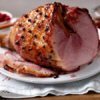
84 Perfect Sunday Lunches
The traditional Sunday Lunch is not a thing of the past - it is making a comeback. When the family gets together for something special.
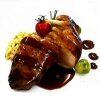
159 Recipes for Entertaining
That moment when you decide to invite friends, relatives or you boss and partner to dinner and you know you need to turn up the originality.
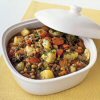
28 Freezer-Friendly Recipes
Not everything is right for freezing. Some foods, however, just beg to go into the freezer waiting for that moment when you need them most!
